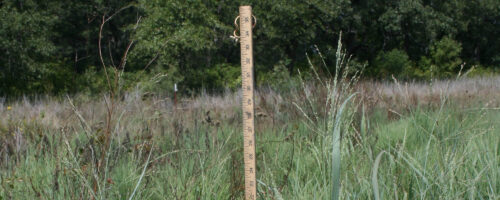Aquatic Vegetation in Ponds
This article originally appeared in the March 1998 Ag News and Views newsletter, revised 2023.
Many pond managers become concerned when they see aquatic vegetation in their ponds. These concerns peak during the growing season when aquatic plants are most visible. Sometimes these concerns are warranted and sometimes they are not. The mere presence of aquatic vegetation in a pond does not constitute a problem.
Whether aquatic vegetation causes problems or not depends on the goals for the pond, the types of vegetation present, and the amounts of vegetation present. For most pond goals, it is very desirable to have some aquatic vegetation present. Aquatic vegetation helps maintain clearer water; it provides fish and wildlife habitat; it helps stabilize pond banks, minimizing bank erosion; it ties-up or denatures many pollutants; and it can increase the attractiveness of a pond.
In biological management situations, everything is relative. Only a little vegetation is acceptable in a catfish culture pond while nearly total coverage of certain plants can be desirable in a waterfowl pond. Livestock watering and sport fishing ponds tend to function best with moderate amounts of aquatic vegetation. Too much of a good thing can become a problem.
When possible, it is best to prevent problems rather than continually working to control problems. The best time to address potential aquatic vegetation problems is during pond construction or reconstruction. Many aquatic plants are depth limited, that is, they grow only in certain water depths. Many aquatic vegetation problems can be prevented by creating adequate depth through most of a pond and shaping most banks to a 20% to 25% slope from full level down to at least 4-5 feet of depth.
Conversely, a waterfowl pond would be designed with lots of shallow water less than 3 feet deep to encourage the growth of aquatic plants. A pond with deeper water and ideally sloped banks should be fenced to prevent livestock from breaking down the bank slopes. An article in the March 1996 and August 1992 issue of NF Ag News & Views provides more information about pond fencing.
Generally, it is not practical to drain and reconstruct an existing pond simply to control an aquatic plant problem. If a pond has overabundant aquatic plants, usually at least three options are available to reduce them:
- modify the pond environment in a manner that makes it less conducive to plant growth,
- stock herbivorous fish to eat the plants, or
- apply aquatic herbicides.
Plants need light and nutrients. Substances that block light or tie-up nutrients modify the pond environment to prevent the growth of many plants. Adding a dye (such as Aquashade, Blue Vail, or True Blue) or mixing clay in the water (causing muddy water) effectively limits light penetration through the water, therefore limiting submersed aquatic plant growth. However, dyed or muddy water generally does not affect emersed or floating plants. Dyed or muddy water generally decreases fish production in a pond. In most situations, muddy water is undesirable because it usually presents a whole new set of problems.
Phosphorus fertilizer, particularly liquid forms, can be applied to a pond to stimulate phytoplankton. Abundant phytoplankton, generally referred to as a phytoplankton bloom, can limit light penetration and tie-up many nutrients in the water. A phytoplankton bloom initiated with fertilizer early in the growing season can prevent most submersed aquatic plant growth. A phytoplankton bloom probably will not decrease emersed and floating plants. Increased phytoplankton can also increase production of some fish species. However, a fertilizer program has some risks. A properly managed fertilizer program requires frequent water quality monitoring and careful fertilizer application to prevent other problems. If a person chooses the fertilizer method, he or she should visit with a fisheries biologist to learn more about this approach.
Grass carp is the primary herbivorous fish species stocked into ponds to control many species of aquatic plants. A couple articles: Grass Carp is an Option to Control Aquatic Plants and Controlling Aquatic Vegetation with Grass Carp discuss the use of grass carp for aquatic vegetation control.
Goldfish can be stocked to reduce filamentous algae in stock tanks or small ponds that do not contain larger predatory fish, such as largemouth bass. We reduced filamentous algae to acceptable levels in 20- to 22-feet diameter metal stock tanks at our Red River Demonstration and Research Farm by stocking about 40 goldfish in each tank. The goldfish were 2.5-5 inches long. Other options for controlling filamentous algae are discussed in the article Filamentous Algae.
Effective use of herbicides generally requires accurate identification of the problem plants. Some herbicides control only certain plant species or plant groups. This selectivity can be an asset because some herbicides allow selective control of problem species while leaving more desirable species unharmed. Most aquatic herbicides contain one of the active ingredients listed in the following table.
Herbicides Labeled For Controlling Aquatic Plantsa
| Active Ingredients | Some Trade Names Available | Plant Controlled |
|---|---|---|
| copper | Algi-Cure, Aquatrine, Captain, Copper sulfate, Cutrine-Plus, Cutrine-Ultra, Komeen, K-Tea | most algae, egeria |
| 2, 4-D amine | Weedar 64, Weed Rhap A-4D | lotus, arrowheads, bulrushes, pennyworts, pickerelweed, rushes, smartweeds, spatterdock, water lilies, water milfoils, water primroses, water shield, water star grass, water willow, willows |
| diquat dibromide | Reward, Weedtrine-D | bladderworts, coontail, elodea, few filamentous algae, naiads, pennyworts, most pondweeds, water fern, water milfoils, water primroses |
| endothall | Aquathol, Aquathol Super K | bur reeds, coontail, most plantains, naiads, pondweeds, water milfoils |
| fluridone | Avast, Sonar | bladderworts, cattails, coontail, duckweeds, egeria, elodea, fanwort, mosquito ferns, naiads, pondweeds, rice cut-grass, southern wild rice, spatterdock, spike sedges, water fern, water lilies, watermeal, some water milfoils, water willow |
| glyphosate | Accord, AquaMaster, AquesPro, Eraser AQ, Glyfos Aquatic, Glypro, Rodeo | lotus, arrowheads, barnyard grass, bulrushes, cattails, common reed, cut-grass, nut sedge, poison hemlock, purple loosestrife, reed canary grass, reeds, smartweeds, southern wax myrtle, southern wild rice, spatterdock, vasey grass, primroses, willows |
| imazamox | Clearcast | alligator weed, arrowheads, cattails, water lily, lotus, pickerelweed, pondweeds, smartweeds, spatterdock, water hyacinth, water pennywort, water primrose |
| imazapyr | Habitat, Polaris, Galleon LZR | arrowheads, bacopas, cattails, common reed, cut-grass, duckweed, duck’s meat, giant reed, jungle rice, nut sedge, parrot feather, pennyworts, pickerelweed, poison hemlock, purple loosestrife, reed canary grass, salt cedar, smartweeds, spatterdock, water lily, water primrose, willows |
| penoxsulam | Galleon | duckweeds, hydrilla, southern naiad, water fern, water hyacinth, water lettuce, water pennywort |
| triclopyr | Garlon 3A, Renovate 3 | lotus, baccharis, cottonwood, pennyworts, pickerelweeds, purple loosestrife, smartweeds, spatterdock, water lilies, water milfoils, water primroses, wax myrtle, willows |
All herbicides provide only temporary control. Control with most herbicides lasts a few weeks to a year. Any herbicide should be used as prescribed on its label. To minimize risks of fish kills, most herbicides used to control submersed or floating plants should be applied early in the growing season before problem plants dominate a pond.
Fish kills can be caused by the decomposition of large quantities of vegetation. Decomposing vegetation uses dissolved oxygen in the water. If dissolved oxygen concentration falls below 2-3 parts per million, fish generally die. Water is generally cooler during the early growing season, which allows water to hold more dissolved oxygen than warmer water later in the growing season. A few aquatic herbicides recommend application later during the growing season.
Glyphosate herbicides, such as Rodeo and Accord, are the primary aquatic herbicides that recommend application later in the growing season on relatively mature plants. These herbicides are generally used on coarse emersed plants that usually decompose more slowly than submersed plants, which minimizes the risks of dissolved oxygen depletion.
To learn more about aquatic vegetation or its control, a person can contact a fisheries biologist or a waterfowl/wetlands biologist with one of the following agencies or organizations: Oklahoma Department of Wildlife Conservation, Texas Parks and Wildlife Department, Oklahoma Cooperative Extension Service, Texas Cooperative Extension Service, U.S. Fish and Wildlife Service, or Natural Resources Conservation Service.



Comment